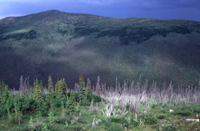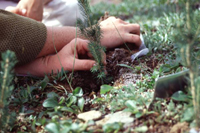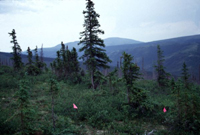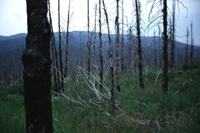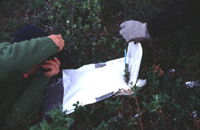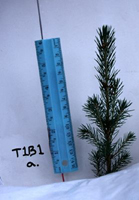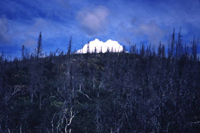|
|
|
Fire and spruce forestsPeople have known for some time that fire has a positive effect on spruce forest regeneration: competing shrubs are removed and the organic (top) layer of soil is burned down to mineral soil, where spruce germinate best. But fire may also have a negative impact, particularly at or above treeline: once the surrounding trees are removed, the harsh conditions may prevent seedlings from surviving. With these two possibilities in mind, what does fire do to spruce at treeline? We want to know this because it probably has some effect on how spruce will respond to global warming. To help figure this out, we traveled to the edge of a fire that burned both at treeline and above treeline-- so where there's forest and tundra and there are places that have burned and haven't burned. At each of these places, we planted spruce seedlings that we will monitor over the next 3 years. Why plant seedlings in these places?During the 3 years, we can look at each group to make comparisons. For instance, how do the seedlings in burned areas compare to the seedlings in unburned areas? In making this comparison, we may learn more about how fire effects spruce seedlings: if the burned ones do considerably better than the unburned ones, we may suspect that fire has a positive effect on early seedling growth. If the unburned seedlings grow better, we may suspect that fire has a negative impact. Once we learn more about if burning or not burning is best for early seedling growth, we can also compare treeline with above treeline. Which place-- above treeline or treeline-- is better for spruce growth? Again, what we learn from the seedling planting experiment will help us figure out how both fire disturbance and warming affect treeline. Although we've planted over 640 seedlings, we still need to travel to other burns to replicate our study so we can have more confidence in our findings. Fire and warmingDuring the 1999 field season, we will warm different groups of the planted seedlings. Why? We hope that artificial warming will mimic global warming so that we can see how fire and warming interact to affect spruce growth. These two things together may have a different effect than either of the two (fire, warming) separately. What did we do?Follow the descriptions and listen to the audio below to further understand what we did.
|
|
|
|
|
|
|
|
All Rights Reserved (R) Middlebury College Biology, 1999, 2000
